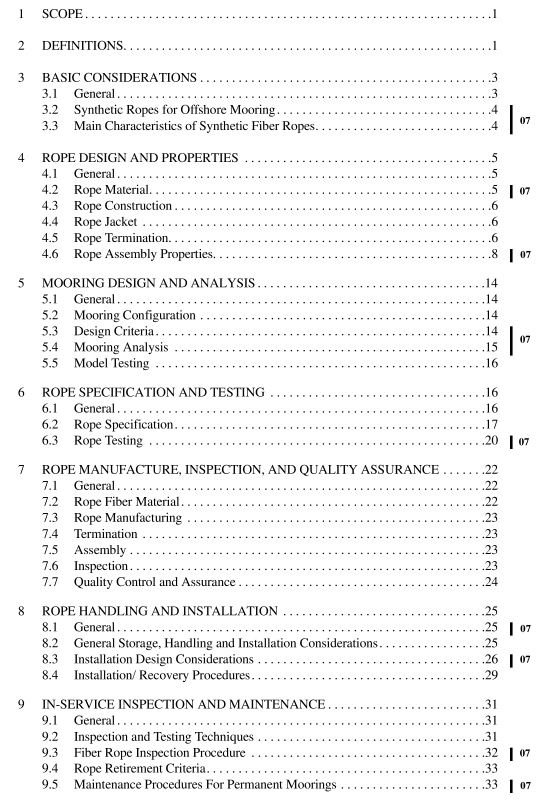API RP 2SM pdf download

API RP 2SM pdf download Recommended Practice for Design, Manufacture, Installation, and Maintenance of Synthetic Fiber Ropes for Offshore Mooring
3.2 SYNTHETIC ROPES FOR OFFSHORE MOORING With increasing exploration and production in deeper waters, it may be advantageous to utilize synthetic ropes that have higher strength to weight ratios than traditional steel wires and chains; however, unlike steel, the synthetic fiber ropes exhibit axial stiffness characteristics that are non-linear and vary with time and loading history. Advantages of using synthetic fiber moorings include a reduction in mooring line weight and hence increases vessel payload, reduction in vessel offset and associated riser costs, reduction in vertical loads and associated structural costs, reduction in the extreme line dynamic tension due to lower tensile stiffness, reduction in expensive handling equipment, and possible reduction in installation cost. Disadvantages of using synthetic fiber moorings are limited design data for large-size ropes and lack of long-term service experience. Fiber ropes may be used as segments in steel catenary sys- tems, or in taut leg mooring systems. This is discussed further in 5.2.
The differences from steel wire/chain mooring systems include: non-linear stiffness, different handling procedures, necessity to keep fiber rope away from fairlead, necessity in some cases to keep fiber rope away from sea floor, axial com- pression fatigue considerations for aramid rope, and creep rupture considerations for HMPE rope.
3.3 MAIN CHARACTERISTICS OF SYNTHETIC FIBER ROPES
3.3.1 Fiber Materials The fibers currently being evaluated for use in permanent or temporary deepwater moorings are polyester (polyethylene terephthalate), aramid (aromatic polyamide), HMPE (high modulus polyethylene) and nylon (polyamide). Detailed data and discussions are available from well-known JIPs [e.g., Refs. 2 and 3]. This does not exclude the use of other synthetic fibers in the design of mooring systems, provided that good engineering practice is followed and all fiber properties are considered. For taut leg mooring (TLM) systems, the synthetic fiber rope axial stretch provides load extension characteristics which the catenary geometry traditionally supplied in the conventional steel system. The lower modulus of elasticity of polyester compared with steel, and relatively low cost makes it suitable for many deepwater TLMs. Other fibers such as HMPEs and aramids may be more suitable for applications where a smaller rope diameter is required (e.g., for frequent handling) or for ultra-deep water TLM applications [5]. Currently, polyester is considered to be a good candidate for the offshore mooring application due to its low stiffness which induces less tension during design storm, good resistance to axial compression fatigue, good fatigue properties, good strength to weight ratio, and good creep resistance.
3.3.2 Rope Construction There are many different rope construction types. Based on test data currently available, two types of rope construction, “wire-rope construction” (WRC, as used in steel wires) and “parallel strand,” are considered in this document.
3.3.3 Rope Elongation and Stiffness Fiber ropes are constructed from fiber materials that display visco-elastic properties. The rope exhibits a non-linear behavior that is dependent on mean load, load range, rate of laoding and load history. After the rope has been tensioned to allow bedding-in, and cyclic load and relaxation has occurred, the stiffness changes with mean load and load range. The rate of loading will also have an effect on dynamic stiffness. As the rope is loaded beyond its previous maximum load, it undergoes a permanent increase in length. The combi- nation of increased length and change in stiffness can result in a softer mooring system. During initial installation and tensioning, and prior to bedding-in and relaxation, it is difficult to define stiffness. In this case the static stiffness can be bounded by the minimum (lower post installation stiffness) and maximum (higher post installation stiffness) values. Similarly, the dynamic stiffness can be bounded by the intermediate and storm stiffness values. This simplified approach, discussed further in 4.6.4, may be used in lieu of a more appropriate stiffness model that matches the non-linear, time dependent nature of polyester rope. For moorings with large synthetic ropes, the installation tension is generally much lower than the maximum design tension. When the mooring line is loaded beyond its installa- tion tenstion, there are two effects that can change the performance of the mooring system. First, the synthetic rope will lengthen due to additional bedding-in or fiber elongation. Second, the static and dynamic stiffnesses of the rope will increase.
The overall effect of the increase in line lenght combined with the increase in mooring line stiffness may be a reduction in effective mooring system stiffness at low loads. Conversely, the mooring system stiffness may increase if the base fiber exhibits low elongation. Platform offsets are a primary concern for risers. Proper evaluation of offsets requires detailed information on the per- manent elongation (bedding-in) and static stiffness of the syn- thetic rope over a range of tensions. Furthermore, the permanent elongation and static stiffness data used for moor- ing performance evaluation need to be representative of the planned mooring operation, including installation tension, pretension and mooring line length management.









